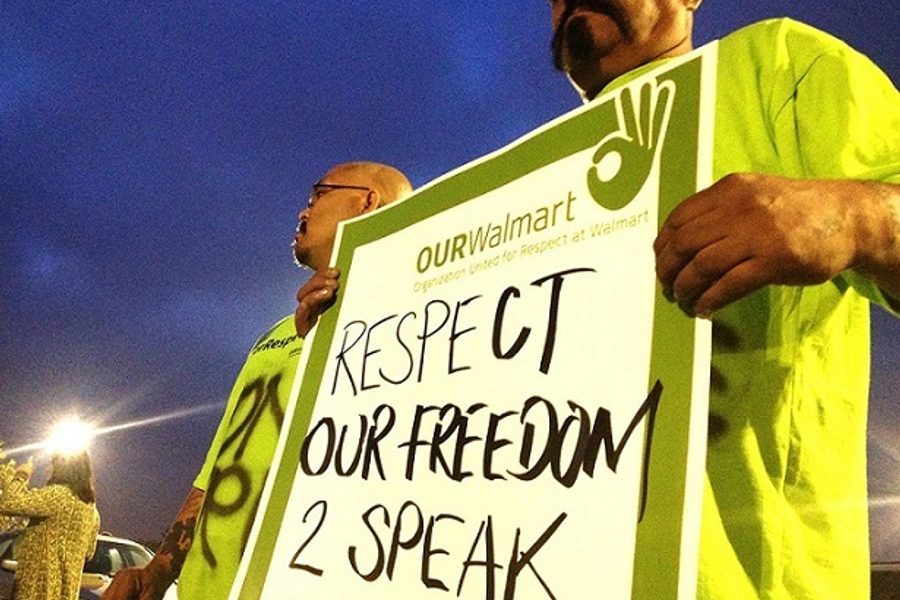
Over the past few months, Walmart retail and supply-chain workers have led strikes, walkouts and other creative actions to challenge the corporation’s unofficial policies of poverty-level wages and regressive working conditions. The Black Friday actions (which swept through the nation on one of Walmart’s most lucrative shopping days) won’t be the last in what promises to be a sustained organizing drive.
Help keep this reporting possible by making a donation today.
Walmart workers have turned the top-down model of union organizing on its head — they are everywhere, re-energizing the labor movement from below. What’s more, the movement is using the struggling economy as a tool to coalesce the diverse working class into a united front for labor justice and organizing rights. Here are eight reasons this action could be looked to as a model for years to come:
-
Walmart organizing cuts across class, race and gender lines.
The 1.4 million-member Walmart workforce is hugely diverse and yet forging a collective identity. The Walmart Winter may well serve as a laboratory for how to unite working people across the old dividing lines.
-
Walmart workers prove the power of direct action in the workplace.
Few successful social movements put all of their eggs in the electoral basket. From the workplace slowdowns and wildcat strikes of the early 20th century to the 2008 occupation of Chicago’s Republic Windows and Doors, direct action is among the most effective tools in the labor activist’s arsenal. And as the country learned from the 1934 general strike that unionized ports up and down the West Coast: Disruption can be the force that turns the tide in favor of workers.
-
A successful Walmart Winter may save cash-strapped state and local budgets.
Walmart employees — who work for one of the most profitable retail operations in human history — shouldn’t have to turn to food stamps to survive. Yet, a study on Walmart and the safety net titled “Hidden Cost of Walmart Jobs: Use of Safety Net Programs by Walmart Workers in California,” showed that low-earning Walmart workers tend to need public assistance, costing California taxpayers $86 million dollars annually.
-
The movement is led by the rank-and-file.
Walmart workers have their own organization, the Organization United for Respect at Walmart (OUR Walmart). While OUR Walmart works closely with organized labor, the workers themselves call most of the shots. This is a growing trend across low-wage organizing efforts. In November, just after Black Friday, NYC fast food workers organizing with Fast Food Forward took to the streets to demand an end to poverty wages.
-
Walmart workers are engaging their communities.
Long before the first strike, OUR Walmart organizers at the national level connected with organizers from community/labor coalitions like Jobs with Justice, the Interfaith Task Force and Family Values at Work to start building the local solidarity and support that has prevented striking workers from being fired for their activities.
-
Walmart workers are setting an example.
By successfully exercise their protected right to collectively act for improved working conditions, Walmart workers provide hope (and an organizing model) to other non-union workers who face the same obstacles in their efforts to make change in their workplaces.
-
Walmart activists are fighting for working families.
Only about 48 percent of US workers have paid sick days. Among low-income workers, the proportion without paid sick leave is a whopping 79 percent. Walmart workers are part of a movement of low-wage workers campaigning for fair paid sick day policies or paid sick time. They are demanding for regular schedules that work for employees and their families, not just Walmart management. Their actions show how low-income workers can stand up to management and define what a “good job” is — one that allows workers to care for themselves and their families. Walmart’s “standards” have often been cited by union employers as reasons to weaken existing protections. Raising standards at Walmart will help stop the race to the bottom at other shops.
-
OUR Walmart is reaching Walmart shoppers.
Connecting with consumers isn’t an easy feat for the labor movement. But many low-wage and working class people shop at Walmart and may be sympathetic to workers. In Oakland, Calif., community members organizing alongside OUR Walmart workers decided to make a direct bid for customer support — by leafleting at a Raiders football tailgate, targeting residents (and possible Walmart shoppers) relaxing only a few blocks from the corporation’s nearby outpost. Organizers were greeted warmly by football fans who often said they had a friend or relative working at Walmart.

